An Efficient Two-Stage Receiver Base on AOR Iterative Algorithm and Chebyshev Acceleration for Uplink Multiuser Massive-MIMO OFDM Systems
Abstract
:1. Introduction
2. System Model
2.1. Uplink Multiuser MIMO OFDMA Systems
2.2. Channel Model
3. Proposed Scheme
3.1. Iteration Method Review
3.1.1. Conventional SOR Method
3.1.2. AOR Method
AOR Convergence Analysis
3.1.3. Chebyshev Acceleration
3.2. Proposed CAOR Method
| Algorithm 1 Chebyshev-Accelerated Over-Relaxation |
| Receiver signal input: 1. , and 2. The first stage: (Initialize phase) 1. 2. 3. set , is the spectral radius of 4. set , , and Compute Compute The second stage: (Refined phase) While not converge do 1. 2. 3. end set Receiver signal output: The estimate of the transmitted signal vector |
4. Simulation Results and Complexity Analysis
4.1. Simulation Results and Discussion
4.2. Computational Complexity Analysis
5. Conclusions
Author Contributions
Funding
Acknowledgments
Conflicts of Interest
Abbreviations
| AOR | Accelerated over-relaxation |
| AWGN | Additive white Gaussian noise |
| BER | Bit error rate |
| BS | Base station |
| CAOR | Chebyshev-accelerated over-relaxation |
| CMAs | Complex multiplications and additions |
| CP | Cyclic prefix |
| CSI | Channel state information |
| i.i.d. | Independent and identically distributed |
| IoT | Internet of Things |
| ISI | Inter-symbol interference |
| LS | Least square |
| M-MIMO | Massive multiple-input multiple-output |
| MIMO | Multiple-input multiple-output |
| MMSE | Minimum mean-squared error |
| MU | Multiuser |
| MUD | Multiuser detector |
| OFDM | Orthogonal frequency-division multiplexing |
| OFDMA | Orthogonal frequency-division multiple access |
| QAM | Quadrature amplitude modulation |
| SOR | Successive over-relaxation |
| SSOR | Symmetric successive over-relaxation |
| ZF | Zero-forcing |
References
- Andrews, J.G.; Buzzi, S.; Choi, W.; Hanly, S.V.; Lozano, A.; Soong, A.C.; Zhang, J.C. What will 5G be? IEEE J. Sel. Areas Commun. 2014, 32, 1065–1082. [Google Scholar] [CrossRef]
- Boccardi, F.; Heath, R.W., Jr.; Lozano, A.; Marzetta, T.L.; Popovski, P. Five Disruptive Technology Directions for 5G. IEEE Commun. Mag. 2014, 52, 74–80. [Google Scholar] [CrossRef] [Green Version]
- Agiwal, M.; Roy, A.; Saxena, N. Next Generation 5G Wireless Networks: A Comprehensive Survey. IEEE Commun. Surv. Tutor. 2016, 18, 1617–1655. [Google Scholar] [CrossRef]
- Al-Fuqaha, A.; Guizani, M.; Mohammadi, M.; Aledhari, M.; Ayyash, M. Internet of Things: A Survey on Enabling Technologies, Protocols, and Applications. IEEE Commun. Surv. Tutor. 2015, 17, 2347–2376. [Google Scholar] [CrossRef]
- Nawara, D.; Kashef, R. IoT-based Recommendation Systems–An Overview. In Proceedings of the 2020 IEEE International IOT, Electronics and Mechatronics Conference (IEMTRONICS), Vancouver, BC, Canada, 9–12 September 2020; pp. 1–7. [Google Scholar]
- Borkar, S.; Pande, H. Application of 5G Next Generation Network to Internet of Things. In Proceedings of the 2016 International Conference on Internet of Things and Applications (IOTA), Pune, India, 22–24 January 2016; pp. 443–447. [Google Scholar]
- Cho, Y.S.; Kim, J.; Yang, W.Y.; Kang, C.G. MIMO-OFDM Wireless Communications with Matlab; John Wiley & Sons: Singapore, 2010. [Google Scholar]
- Prasad, R. OFDM for Wireless Communications Systems; Artech: Norwood, MA, USA, 2004. [Google Scholar]
- Gesbert, D.; Shafi, M.; Shiu, D.S.; Smith, P.J.; Naguib, A. From Theory to Practice: An Overview of MIMO Space-Time Coded Wireless Systems. IEEE J. Sel. Areas Commun. 2003, 21, 281–302. [Google Scholar] [CrossRef] [Green Version]
- Paulraj, A.J.; Gore, D.A.; Nabar, R.U.; Bölcskei, H. An Overview of MIMO Communications—A Key to Gigabit Wireless. Proc. IEEE 2004, 92, 198–218. [Google Scholar] [CrossRef] [Green Version]
- Di Renzo, M.; Haas, H.; Ghrayeb, A.; Sugiura, S.; Hanzo, L. Spatial modulation for generalized MIMO: Challenges, opportunities, and implementation. IEEE Trans. Veh. Technol. 2014, 57, 2228–2241. [Google Scholar] [CrossRef]
- Stuber, G.L.; Barry, J.R.; McLaughlin, S.W.; Li, Y.G.; Ingram, M.A.; Pratt, T.G. Broadband MIMO-OFDM Wireless Communications. Proc. IEEE 2004, 92, 271–294. [Google Scholar] [CrossRef] [Green Version]
- Hwang, T.; Yang, C.; Wu, G.; Li, S.; Li, G.Y. OFDM and Its Wireless Applications: A Survey. IEEE Trans. Veh. Technol. 2009, 58, 1673–1694. [Google Scholar] [CrossRef]
- Lu, L.; Li, G.Y.; Swindlehurst, A.L.; Ashikhmin, A.; Zhang, R. An Overview of Massive MIMO: Benefits and Challenges. IEEE J. Sel. Top. Signal Process. 2014, 8, 742–758. [Google Scholar] [CrossRef]
- Larsson, E.G.; Tufvesson, F.; Edfors, O.; Marzetta, T.L. Massive MIMO for Next Generation Wireless Systems. IEEE Commun. Mag. 2014, 52, 186–195. [Google Scholar] [CrossRef] [Green Version]
- Zheng, K.; Zhao, L.; Mei, J.; Shao, B.; Xiang, W.; Hanzo, L. Survey of Large-Scale MIMO Systems. IEEE Commun. Surv. Tutor. 2015, 17, 1738–1760. [Google Scholar] [CrossRef] [Green Version]
- Björnson, E.; Larsson, E.G.; Marzetta, T.L. Massive MIMO: Ten Myths and One Critical Question. IEEE Commun. Mag. 2016, 54, 114–123. [Google Scholar] [CrossRef] [Green Version]
- Marzetta, T.L. Noncooperative Cellular Wireless with Unlimited Numbers of Base Station Antennas. IEEE J. Sel. Areas Commun. 2010, 9, 3590–3600. [Google Scholar] [CrossRef]
- Hoydis, J.; ten Brink, S.; Debbah, M. Massive MIMO in the UL/DL of Cellular Networks: How Many Antennas Do We Need? IEEE J. Sel. Areas Commun. 2013, 31, 160–171. [Google Scholar] [CrossRef] [Green Version]
- Rusek, F.; Persson, D.; Lau, B.K.; Larsson, E.G.; Marzetta, T.L.; Edfors, O.; Tufvesson, F. Scaling Up MIMO: Opportunities and Challenges with Very Large Arrays. IEEE Signal Process. Mag. 2013, 30, 40–60. [Google Scholar] [CrossRef] [Green Version]
- Larsson, E.G. MIMO Detection Methods: How They Work [lecture notes]. IEEE Signal Process. Mag. 2009, 26, 91–95. [Google Scholar] [CrossRef] [Green Version]
- Wu, M.; Yin, B.; Wang, G.; Dick, C.; Cavallaro, J.R.; Studer, C. Large-Scale MIMO Detection for 3GPP LTE: Algorithms and FPGA Implementations. IEEE J. Sel. Top. Signal Process. 2014, 8, 916–929. [Google Scholar] [CrossRef] [Green Version]
- Yin, B.; Wu, M.; Studer, C.; Cavallaro, J.R.; Dick, C. Implementation Trade-Offs for Linear Detection in Large-Scale MIMO Systems. In Proceedings of the IEEE Acoustics, Speech and Signal Processing (ICASSP), Vancouver, BC, Canada, 26–31 May 2013; pp. 2679–2683. [Google Scholar]
- Albreem, M.A.; Salah, W.; Kumar, A.; Alsharif, M.H.; Rambe, A.H.; Jusoh, M.; Uwaechia, A.N. Low Complexity Linear Detectors for Massive MIMO: A Comparative Study. IEEE Access 2021, 9, 45740–45753. [Google Scholar] [CrossRef]
- Kong, B.Y.; Park, I.C. Low-Complexity Symbol Detection for Massive MIMO Uplink Based on Jacobi Method. In Proceedings of the IEEE Annual International Symposium on Personal, Indoor, and Mobile Radio Communications (PIMRC), Valencia, Spain, 4–8 September 2016; pp. 1–5. [Google Scholar]
- Wu, Z.; Zhang, C.; Xue, Y.; Xu, S.; You, X. Efficient Architecture for Soft-Output Massive MIMO Detection with Gauss-Seidel Method. In Proceedings of the IEEE International Symposium on Circuits and Systems (ISCAS), Montreal, QC, Canada, 22–25 May 2016; pp. 1886–1889. [Google Scholar]
- Gao, X.; Dai, L.; Hu, Y.; Wang, Z.; Wang, Z. Matrix Inversion-Less Signal Detection Using SOR Method for Uplink Large-Scale MIMO Systems. In Proceedings of the IEEE Global Communications Conference (GLOBECOM), Austin, TX, USA, 8–12 December 2014; pp. 3291–3295. [Google Scholar]
- Yu, A.; Zhang, C.; Zhang, S.; You, X. Efficient SOR-Based Detection and Architecture for Large-Scale MIMO Uplink. In Proceedings of the 2016 IEEE Asia Pacific Conference on Circuits and Systems (APCCAS), Jeju, Korea, 25–28 October 2016; pp. 402–405. [Google Scholar]
- Ning, J.; Lu, Z.; Xie, T.; Quan, J.; You, X. Low Complexity Signal Detector Based on SSOR Method for Massive MIMO Systems. In Proceedings of the 2015 IEEE International Symposium on Broadband Multimedia Systems and Broadcasting (BMSB), Ghent, Belgium, 17–19 June 2015; pp. 1–4. [Google Scholar]
- Zhang, Z.; Dai, X.; Dong, Y.; Wang, X.; Liu, T. A Low-Complexity Signal Detection Utilizing AOR Iterative Method for Massive MIMO Systems. China Commun. 2017, 9, 269–278. [Google Scholar] [CrossRef]
- Young, D.M. Iterative Solution of Large Linear Systems; Elsevier: Amsterdam, The Netherlands, 2014. [Google Scholar]
- Morelli, M.; Kuo, C.-C.J.; Pun, M.-O. Synchronization Techniques for Orthogonal Frequency Division Multiple Access (OFDMA): A Tutorial Review. Proc. IEEE 2007, 95, 1394–1427. [Google Scholar] [CrossRef]
- Ng, D.; Lo, E.; Schober, R. Energy-Efficient Resource Allocation in OFDMA Systems with Large Numbers of Base Station Antennas. IEEE Trans. Wirel. Commun. 2012, 11, 3292–3304. [Google Scholar] [CrossRef]
- Coleri, S.; Ergen, M.; Puri, A.; Bahai, A. Channel Estimation Techniques Based On Pilot Arrangement in OFDM Systems. IEEE Trans. Broadcast. 2002, 48, 223–229. [Google Scholar] [CrossRef] [Green Version]
- Van de Beek, J.; Edfors, O.; Sandell, M.; Wilson, S.K.; Borjesson, P.O. On Channel Estimation in OFDM Systems. In Proceedings of the IEEE 45th Vehicular Technology Conference, Chicago, IL, USA, 25–28 July 1995; pp. 815–819. [Google Scholar]
- Hadjidimos, A. Successive overrelaxation (SOR) and related methods. Comput. Appl. Math. 2000, 123, 177–199. [Google Scholar] [CrossRef] [Green Version]
- Hadjidimos, A. Accelerated Overrelaxation Method. Math. Comput. 1978, 32, 149–157. [Google Scholar] [CrossRef]


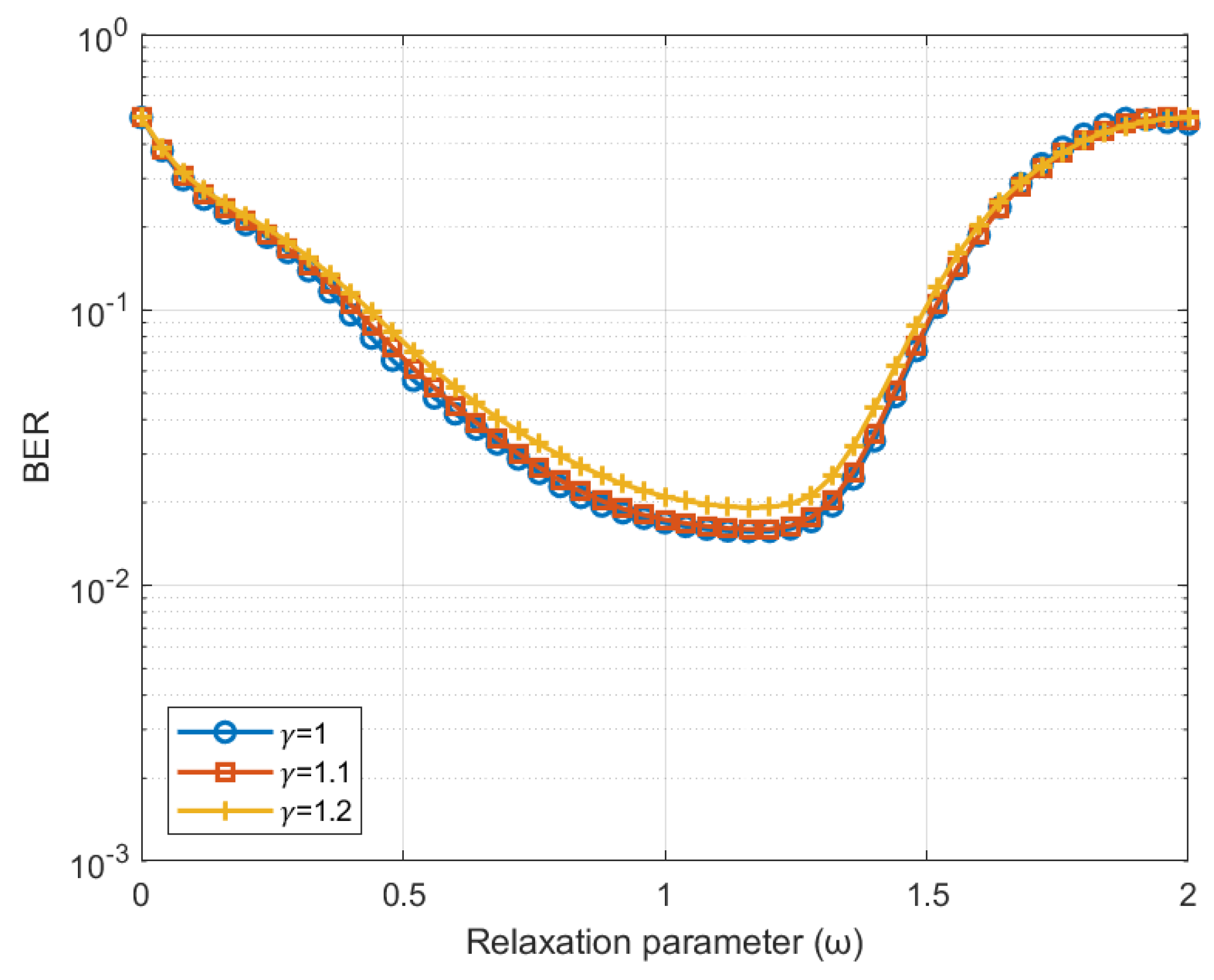
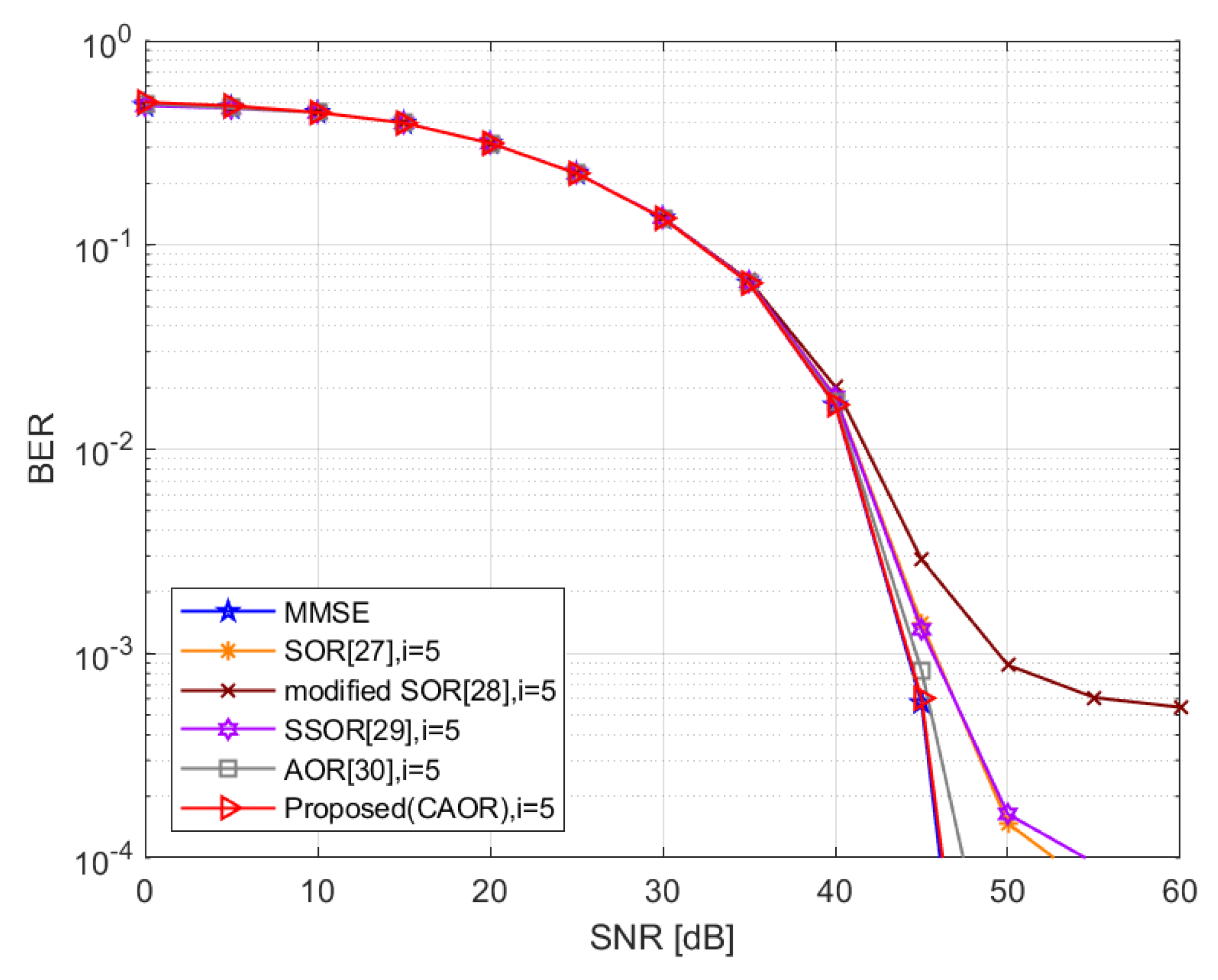


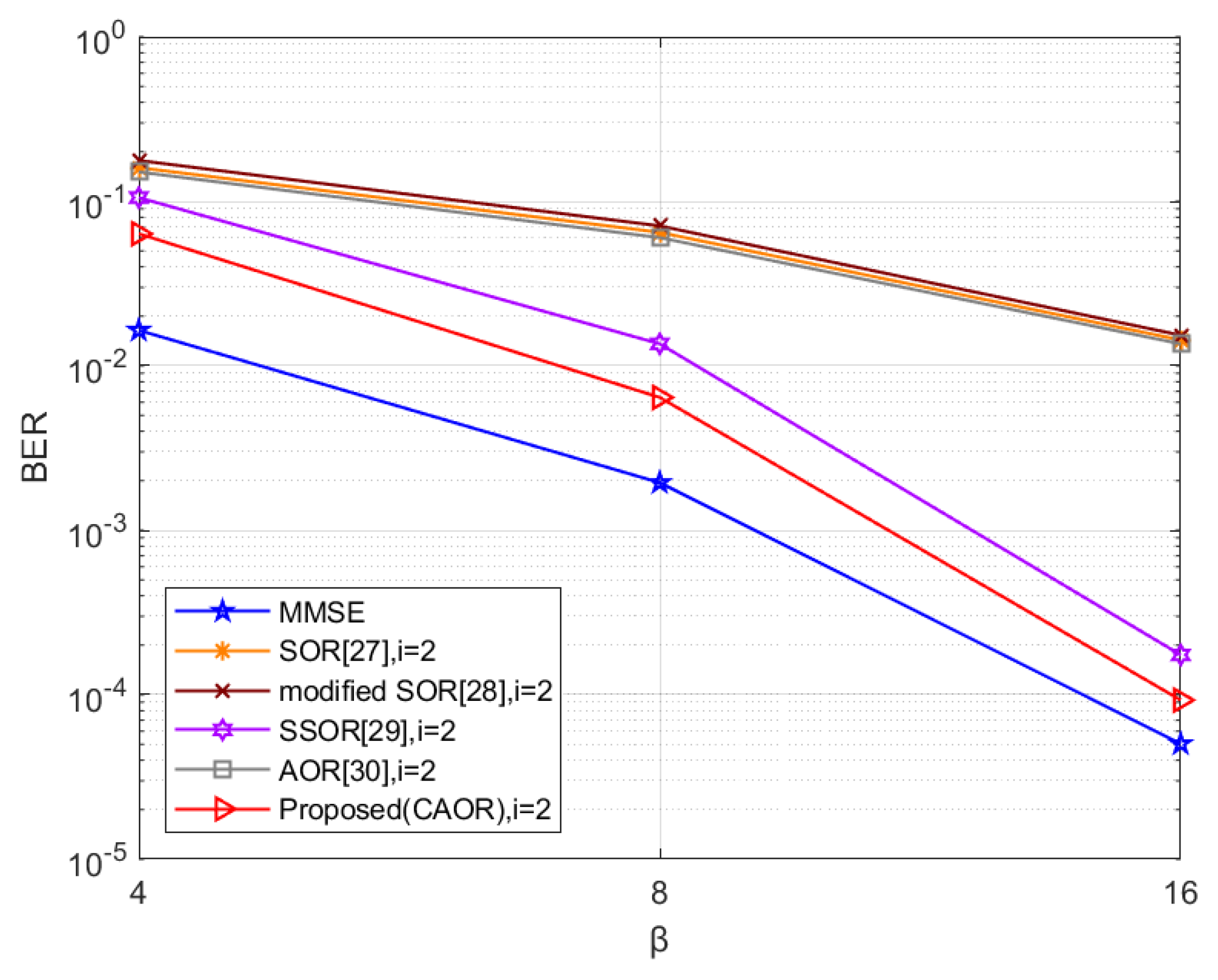

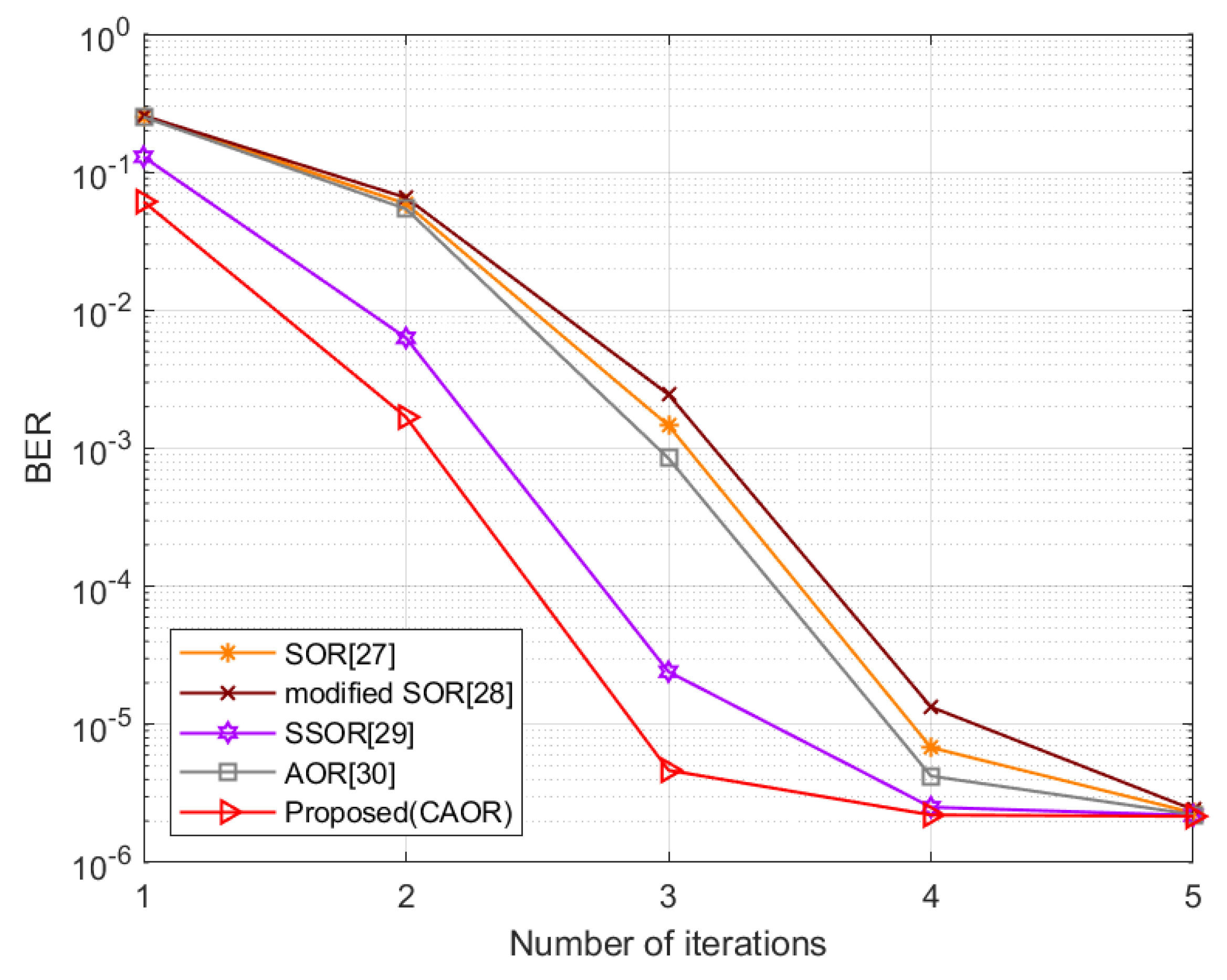

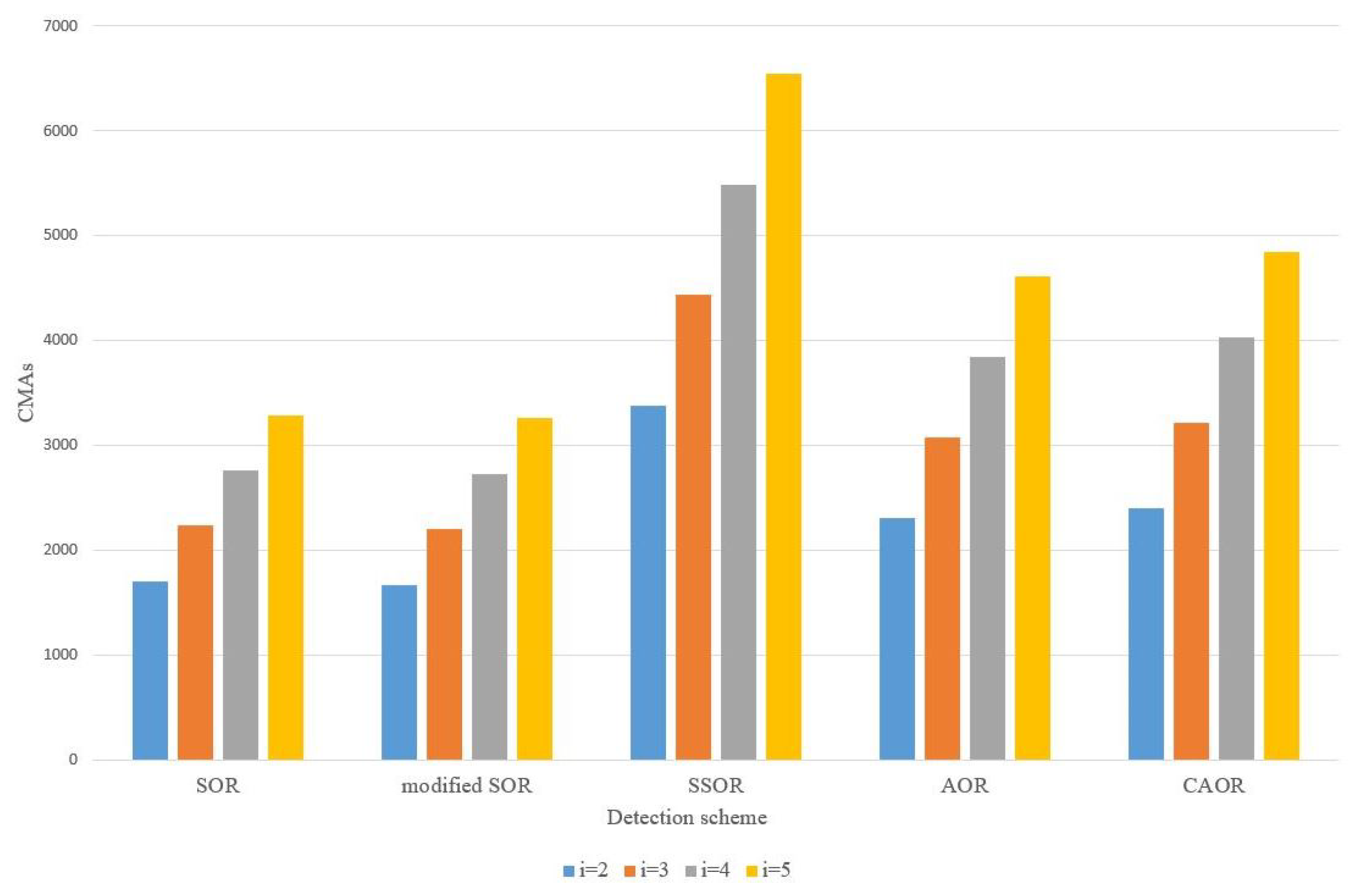
| System | Parameter |
|---|---|
| Number of data subcarriers | 256 |
| Number of OFDM symbols | 100 |
| Modulation scheme | 1024-QAM |
| CP Length | 64 |
| Number of pilot data in one OFDM symbol | 20 |
| The maximum SNR | 60 |
| Channel | Rayleigh fading channel |
| Number of channel taps | 2 |
| Noise | AWGN |
| Channel estimation | LS |
| Monte Carlo (times) | 10,000 |
| Scheme | Brief Description |
|---|---|
| SOR [27] | SOR is a method of solving a linear system of equations derived by extrapolating the Gauss–Seidel method. |
| modified SOR [28] | Modified SOR is a variant of SOR, which changes certain parameters in the SOR algorithm and is nearly unaffected by the relaxation factor in lower modulation order. |
| SSOR [29] | SSOR combines two SOR sweeps in such a way that the resulting iteration matrix is similar to a symmetric matrix. |
| AOR [30] | The AOR iterative algorithm can be regarded as an extension of the SOR iterative algorithm, which is a two-parameter generalization of the SOR method. |
| CAOR | The CAOR method combines the AOR iterative algorithm and the recursive characteristics of the Chebyshev polynomials. |
| Scheme | |||
|---|---|---|---|
| SOR | 9.43 dB | 15.19 dB | 24.52 dB |
| modified SOR | 9.91 dB | 15.60 dB | 24.82 dB |
| SSOR | 7.34 dB | 7.89 dB | 3.93 dB |
| AOR | 9.13 dB | 14.86 dB | 24.30 dB |
| CAOR | 4.58 dB | 3.74 dB | −0.738 dB |
| Scheme | |||
|---|---|---|---|
| SOR | 44.35 dB | 28.40 dB | 3.31 dB |
| modified SOR | 44.80 dB | 30.62 dB | 7.14 dB |
| SSOR | 34.63 dB | 10.05 dB | −7.90 dB |
| AOR | 43.98 dB | 25.91 dB | −0.21 dB |
| CAOR | 28.94 dB | 0.61 dB | −16.88 dB |
| Scheme | ||
|---|---|---|
| SOR | 59.64% | 91.08% |
| modified SOR | 59.97% | 91.36% |
| SSOR | 87.08% | 99.83% |
| AOR | 60.12% | 90.98% |
| CAOR | 89.92% | 99.85% |
| Detection Scheme | Complex Multiplications and Additions (CMAs) |
|---|---|
| SOR | |
| modified SOR | |
| SSOR | |
| AOR | |
| CAOR |
| Detection | CMAs | CMAs | CMAs | CMAs |
|---|---|---|---|---|
| Scheme | ||||
| SOR | 1704 | 2232 | 2760 | 3288 |
| modified SOR | 1672 | 2200 | 2728 | 3256 |
| SSOR | 3376 | 4432 | 5488 | 6544 |
| AOR | 2304 | 3072 | 3840 | 4608 |
| CAOR | 2400 | 3216 | 4032 | 4848 |
Publisher’s Note: MDPI stays neutral with regard to jurisdictional claims in published maps and institutional affiliations. |
© 2021 by the authors. Licensee MDPI, Basel, Switzerland. This article is an open access article distributed under the terms and conditions of the Creative Commons Attribution (CC BY) license (https://creativecommons.org/licenses/by/4.0/).
Share and Cite
Tu, Y.-P.; Chen, C.-Y.; Lin, K.-H. An Efficient Two-Stage Receiver Base on AOR Iterative Algorithm and Chebyshev Acceleration for Uplink Multiuser Massive-MIMO OFDM Systems. Electronics 2022, 11, 92. https://doi.org/10.3390/electronics11010092
Tu Y-P, Chen C-Y, Lin K-H. An Efficient Two-Stage Receiver Base on AOR Iterative Algorithm and Chebyshev Acceleration for Uplink Multiuser Massive-MIMO OFDM Systems. Electronics. 2022; 11(1):92. https://doi.org/10.3390/electronics11010092
Chicago/Turabian StyleTu, Yung-Ping, Chih-Yung Chen, and Kuang-Hao Lin. 2022. "An Efficient Two-Stage Receiver Base on AOR Iterative Algorithm and Chebyshev Acceleration for Uplink Multiuser Massive-MIMO OFDM Systems" Electronics 11, no. 1: 92. https://doi.org/10.3390/electronics11010092
APA StyleTu, Y.-P., Chen, C.-Y., & Lin, K.-H. (2022). An Efficient Two-Stage Receiver Base on AOR Iterative Algorithm and Chebyshev Acceleration for Uplink Multiuser Massive-MIMO OFDM Systems. Electronics, 11(1), 92. https://doi.org/10.3390/electronics11010092






